
Have you ever felt a pinching sensation in your pelvis, a few inches below your waist? If so, you’re not alone. From my experience, and that of a couple internationally touring teachers I know, pain in the sacroiliac, a.k.a. SI joint is one of the most common complaints of yoga practitioners of all experience levels.
The SI joint is the meeting place between the sacrum and the ilium. The sacrum is a triangular-shaped bone that extends off the lumbar spine and ends in the coccyx (tailbone). In other words, it’s the lowest portion of your spine. The two sides pelvic bones make up the ilia. Where the sacrum and ilia meet in the ilia is the SI joint.
The SI Joint: Mobile Stability
Donna Farhi calls the SI joint a joint of “mobile stability.” What this means is that while it does have some mobility—about 1 to 3 millimeters of movement capability—its primary function is stability. The SI joint is the hub for the transmission of force from the lower to the upper body and the upper to the lower body. In order for force to move through the joint smoothly, the joint must be in integrity. This means that the sacrum must be firmly seated in the ilium for maximum stability.
3 Yoga Practices that May Contribute to SI Joint Dysfunction
What can cause the SI joint to lose integrity? Here are a few things I’ve learned over the decades of teaching yoga, and experiencing my own chronic SI joint pain:
Tucking the Tailbone
The sacrum seats firmly into the ilium when it is tilted forward at approximately a 30-degree angle. When we tuck the tailbone, the sacrum moves into a more vertical position, which causes the sacrum to lose its firm contact.
Squaring the Hips
The outdated, but persistent, instruction to square the hips in asymmetrical standing poses such as Trikonasana (Triangle Pose) or the Warrior poses is one of yoga’s most potent SI joint destabilizers. No one’s hips are designed to do this. When you try to square the hips in asymmetrical standing poses, something has to give—the knees, the hip joints and/or the SI joint. Variations in the placement, depth and orientation of individual hip sockets makes this instruction even more fraught, particularly if you or your students have hip joints that do not externally rotate easily.
Too Much Focus on Hip Opening
Modern yoga seems to fetishize hip hypermobility. If you think about it, the hips—which include the hip joints, SI joints and pubic symphysis—need to be stable above all. They are supporting the weight of our bodies as we move through our lives. Too much flexibility destabilizes the joints by over stretching the ligaments.
Ligaments do not have the blood supply and therefore, the “memory” that muscle tissue has. In other words, when we over stretch ligaments, they do not recover their original length; they stay overstretched. Then the muscles have to kick in to do the job of stabilizing the joint, which actually causes them to tighten. Here’s one piece of advice that could help everyone preserve their SI joints: Disabuse yourself of the idea that putting your ankle behind your head is a good thing. There’s no reason ever to do this. This pose destabilizes the hip joints and the SI joints and can wear down the cartilage in your hip joints. Even if it feels fine while you’re doing it, don’t!
So, in this post, I’ve outlined some yoga practices that might contribute to SI joint dysfunction. In coming posts, I’ll offer some ways to practice asana to help alleviate the pain from SI joint dysfunction and ways to prevent further injury.
